Table of Contents |
All organisms require certain conditions for growth and microbes are no exception. For example, humans become physiologically stressed if they are too hot or cold, and extreme conditions can even be lethal. The same is true for other organisms.
In this lesson, you will learn about some of the most critical environmental factors that influence environmental growth. However, it is important to remember that the environment can vary in diverse ways and microbes can be affected by many factors beyond those discussed here.
For humans and many other organisms, oxygen is essential for life. As you may remember from the tutorials on metabolism, oxygen is the terminal electron acceptor of the electron transport chain used in cellular respiration. This means that it is essential for organisms such as humans to produce sufficient ATP to survive.
However, atmospheric oxygen (molecular oxygen, or O2) is only one form of oxygen in nature. Oxygen can also form reactive oxygen species (ROS), which are highly unstable and potentially harmful to living organisms. These include singlet oxygen (1O2), superoxide (O2−), peroxides such as hydrogen peroxide (H2O2), and hydroxyl radical (OH∙; note that the radical differs from a hydroxide ion in that it has a single unpaired electron on oxygen and no charge). The hypochlorite ion (OCl−), which is the active ingredient in household bleach, is another example and a reason why bleach is so effective as a disinfectant (a term that you will study in more detail in the tutorial on chemical control of microbes).
To thrive in an oxygen-rich environment, organisms need ways to detoxify ROS. They can accomplish this using specialized enzymes. In particular, the following three enzymes are used: peroxidases, superoxide dismutase, and catalase.
Genetic analysis is commonly used to identify microbes now that it is becoming increasingly readily available, but one test that used to be commonly used in identification was a catalase test. By adding a drop of catalase to a sample, it was possible to determine whether the microbes produced catalase (and therefore bubbles) or not (leaving clear liquid). In the photo below, the sample of clear liquid on the left is catalase negative because the microbes did not have catalase and the sample of bubbling liquid on the right is catalase positive because the microbes did have catalase. This test is still very useful to distinguish aerotolerant streptococci that lack catalase from staphylococci, which are facultative anaerobes that have catalase.
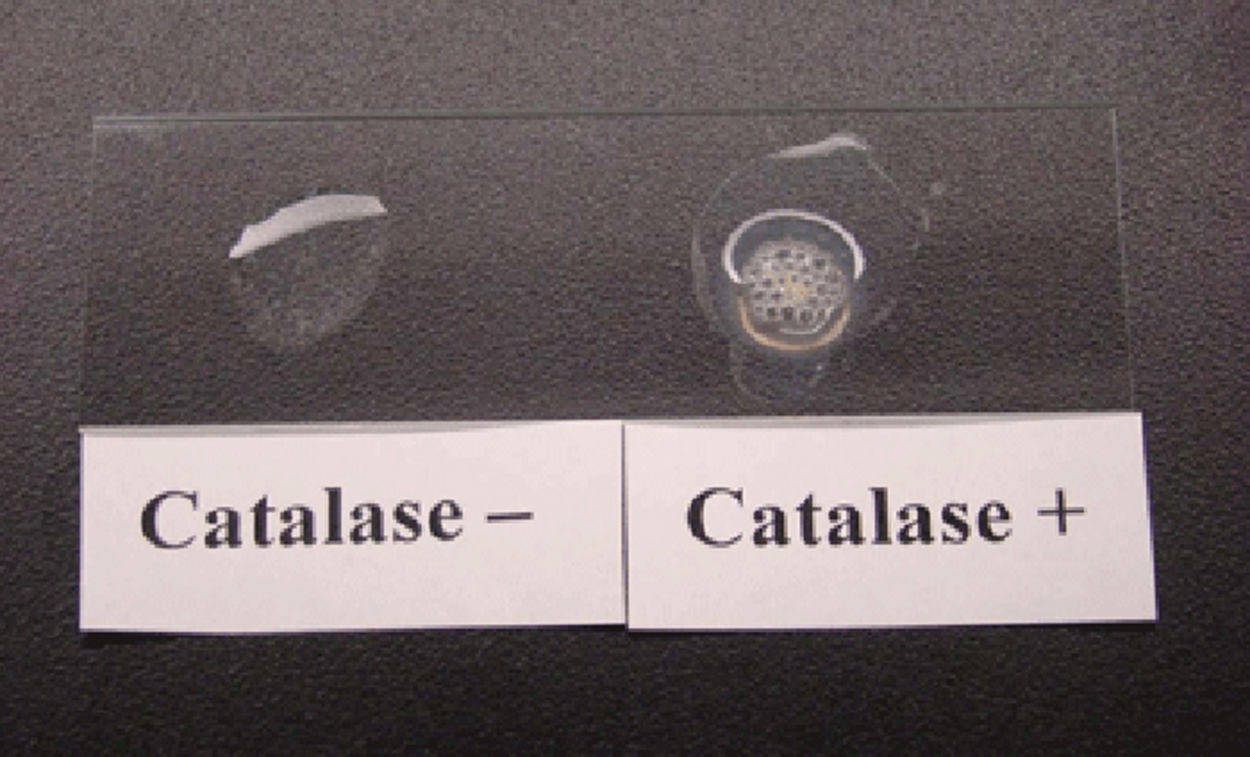
One way to observe the different requirements for molecular oxygen is by growing bacteria in thioglycolate tube cultures. This medium has a low percentage of agar, allowing microbes to move throughout the test tube. Because thioglycolate has strong reducing properties and autoclaving to remove contaminating bacteria removes oxygen, oxygen gradually diffuses through the culture from the environment starting at the top of the culture tube. Therefore, there is a gradient of oxygen that is high at the top and decreases deeper in the tube.
When bacteria are inoculated into thioglycolate medium, their growth pattern reflects their oxygen requirements and tolerance. The image and table below illustrate the following types of bacteria.
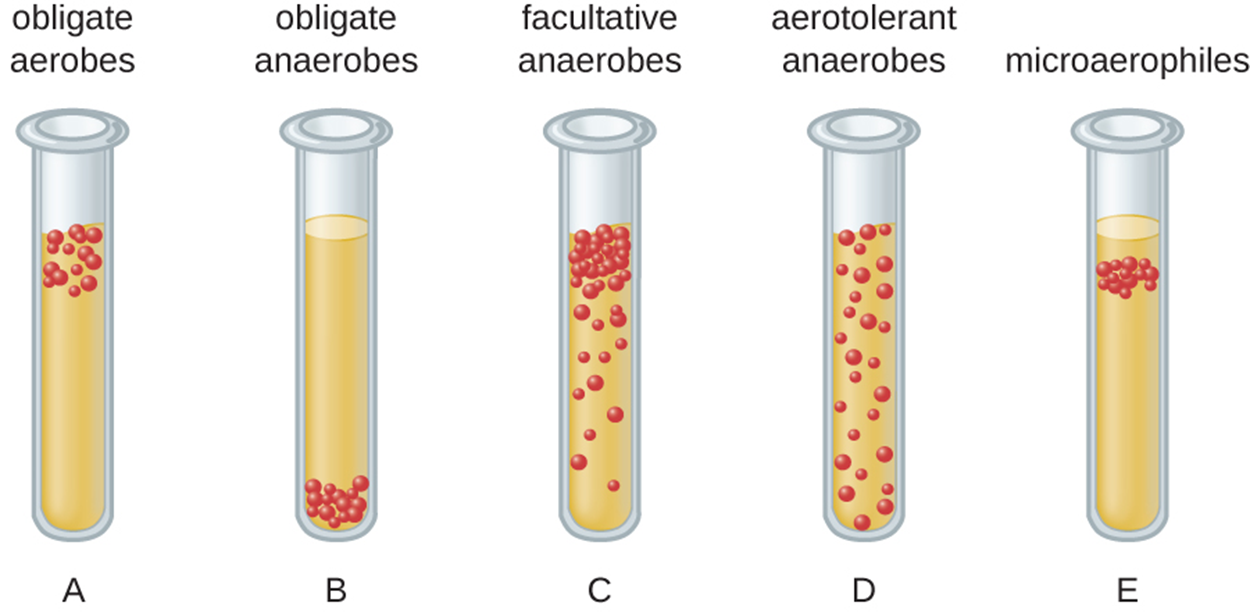
| Tube | Term | Oxygen Requirements |
|---|---|---|
| Tube A | Obligate aerobes | They require oxygen and only grow near the top of the medium. |
| Tube B | Obligate anaerobes | They require an oxygen-free environment and only grow near the bottom of the medium. |
| Tube C | Facultative anaerobes | They can grow with or without oxygen but can use aerobic respiration to produce more ATP when oxygen is present. Therefore, they are most abundant near the top of the medium but found throughout the tube. |
| Tube D | Aerotolerant anaerobes | They are not affected by the presence or absence of oxygen and grow evenly throughout the tube. |
| Tube E | Microaerophiles | They require a low concentration of oxygen (below the concentration of oxygen in the atmosphere) and grow near but below the surface of the medium where the oxygen concentration is about 1–10% (versus approximately 21% in the atmosphere). |
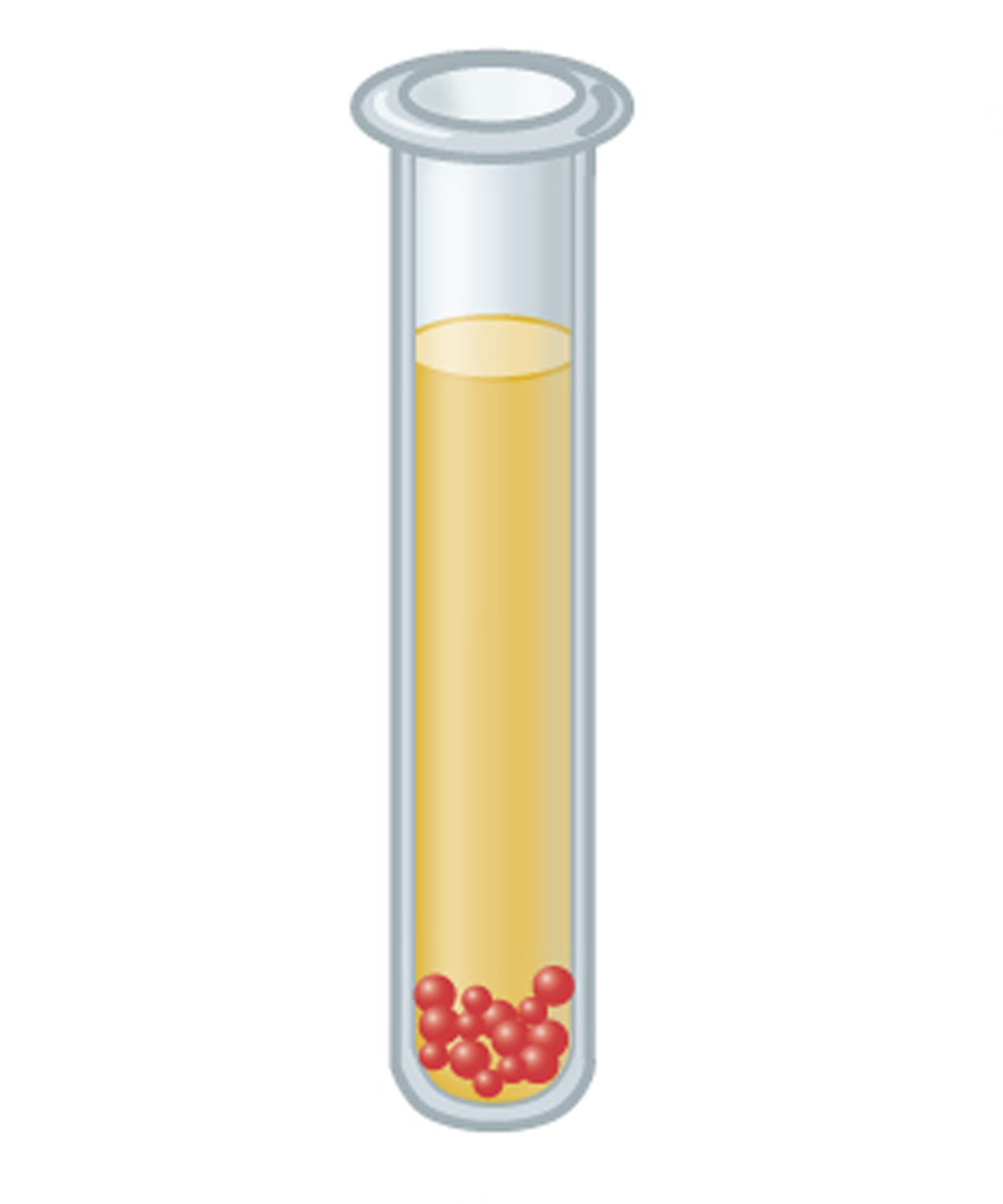
Obligate anaerobes generally lack peroxidases, catalases, and superoxide dismutase. Aerotolerant anaerobes have superoxide dismutase but no catalase.
Obligate anaerobes are common in nature. The image below shows two examples. Part (a) shows a photo of a bog where there are many areas of dense sediments that are often anaerobic when undisturbed. Part (b) shows cows that have anaerobic microbes living in their rumens. The rumen is a pouch off of the esophagus where plant matter can be digested by microbes to help cows and other ruminants extract more nutrition from it.

Special equipment is required to grow strict (obligate) anaerobes. The image below shows two examples. Part (a) shows an anaerobic jar containing petri dishes of medium. This jar contains chemical packs to remove oxygen and release carbon dioxide. Part (b) shows an anaerobic chamber. It is possible to use the gloves attached to the side to manipulate cultures within the oxygen-free environment inside the chamber.
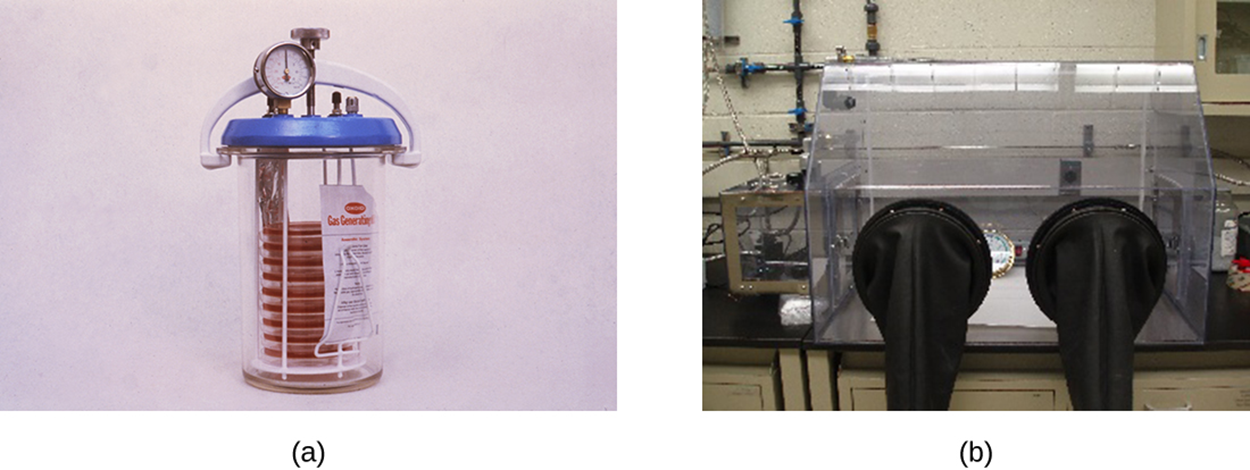
All organisms have an optimum oxygen concentration at which they grow best. The minimum permissive oxygen concentration is the lowest oxygen concentration at which they can grow, whereas the maximum permissive oxygen concentration is the highest oxygen concentration at which they can grow.
Another important environmental factor to consider is pH. Among other effects, pH influences the structure of molecules such as proteins (including enzymes).
Organisms also have varying tolerances for pH. The optimum growth pH is the most favorable pH for growth. The minimum growth pH and the maximum growth pH are the lowest and highest pH values that an organism can tolerate, respectively. These values may be influenced by other environmental factors.
Most bacteria are neutrophiles, meaning that they grow best at a pH of around 7. Acidophiles are organisms that grow optimally at pH values below 5.55 and alkaliphiles grow optimally at pH values between 8.0 and 10.5. The image below shows examples of growth rates at varying pH values for each of these types of organisms.
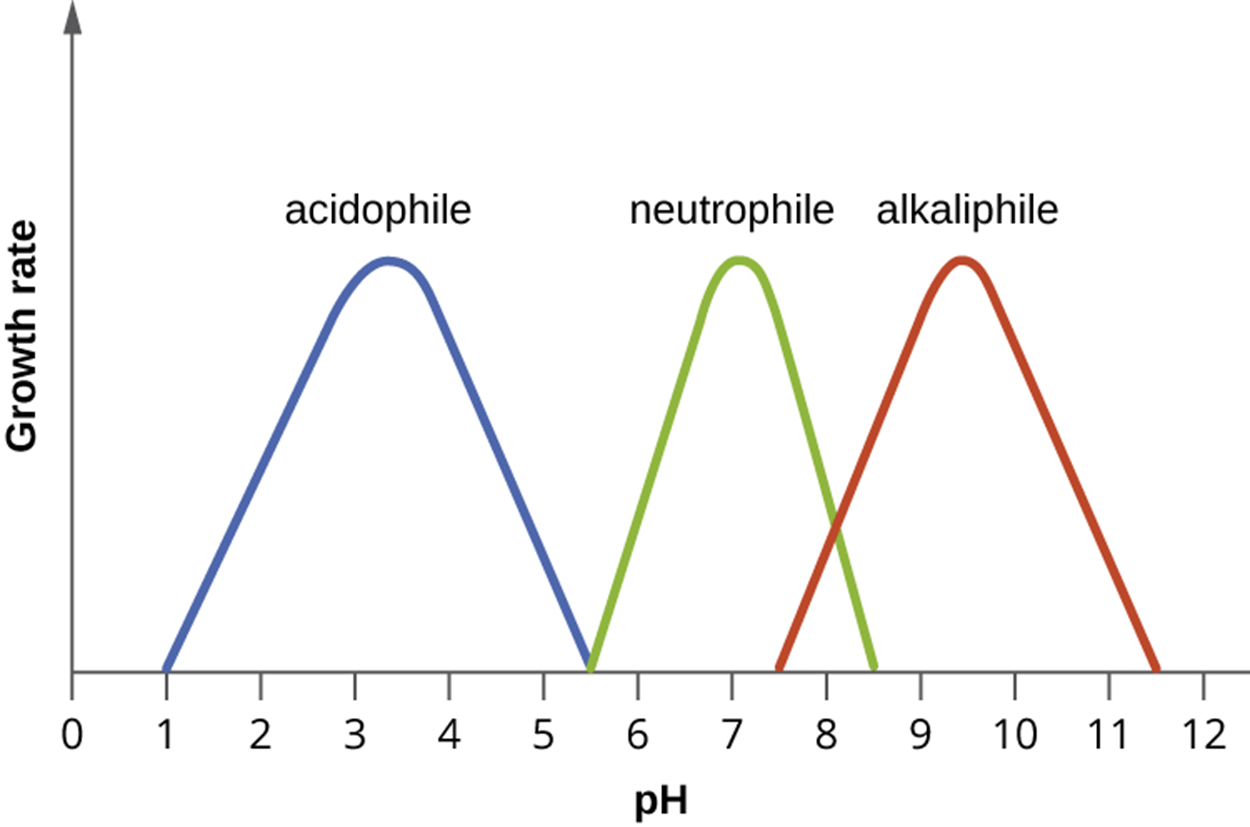
Microbes that grow at extreme pH values have specialized adaptations that allow them to thrive under these conditions. Microbes also often affect the pH of their environment (e.g., by producing acidic fermentation products). For many years, it was thought that bacteria could not survive in the stomach because of the low pH of stomach acid. However, it is now known that multiple species (most famously Helicobacter pylori) can survive in the stomach and are associated with conditions such as stomach ulcers and stomach cancer (e.g., Liu et al., 2022).
The photo below shows a view from space of Lake Natron in Tanzania. This lake is bright to pale pink because of the growth of microbes that can thrive in the highly alkaline and saline environment.
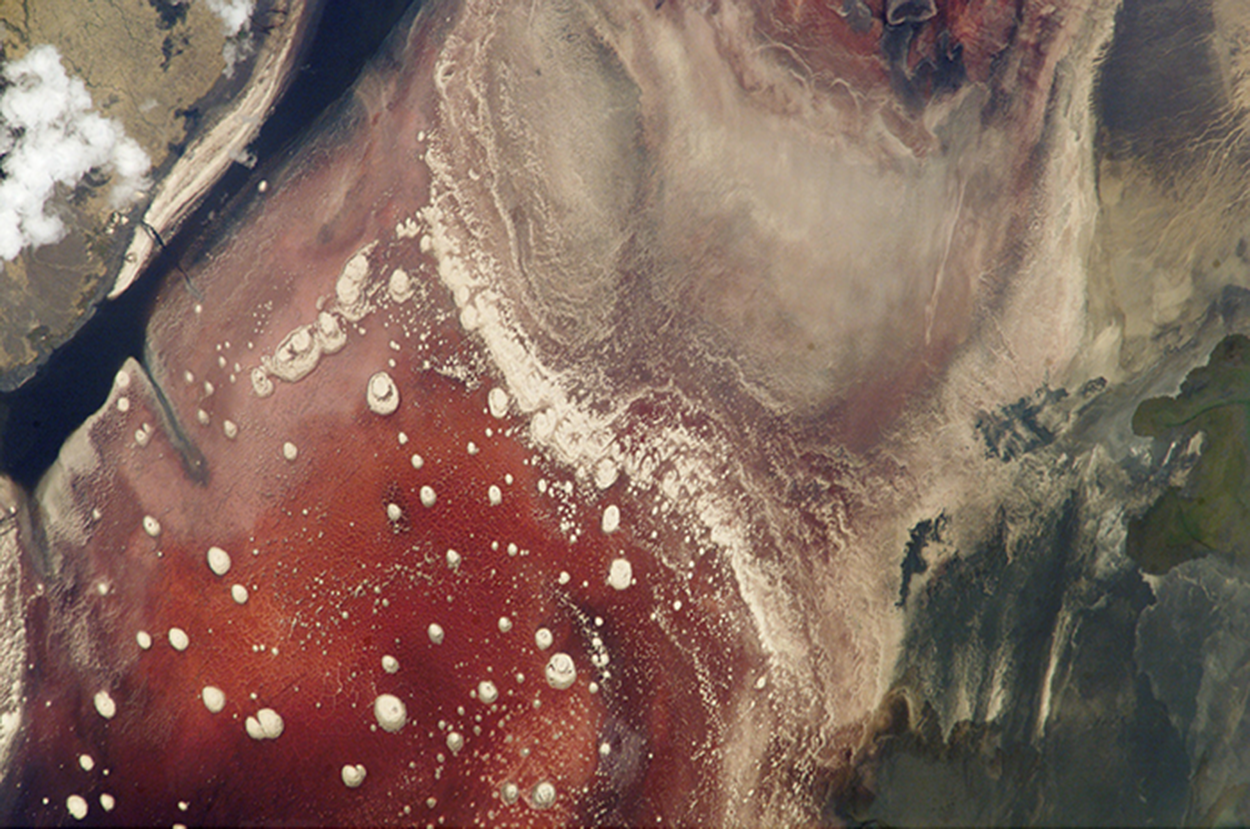
As with pH, temperature affects many characteristics of organisms. For example, it affects the structure and function of proteins (such as enzymes) and membranes. Therefore, organisms need specialized adaptations to live at particular temperatures.
The optimum growth temperature is the temperature at which an organism grows most rapidly. The maximum growth temperature is the highest temperature at which growth can occur. The minimum growth temperature is the lowest temperature at which growth can occur. However, all of these values may be influenced by changes in other environmental factors that interact with the effects of temperature.
The photo below shows a deep sea vent and is an example of an environment containing an abundance of life highly specialized for a hot environment. The overall structure is called a black smoker and plumes of black smoke can be seen emerging from the base, which is covered with red and white tubeworms.
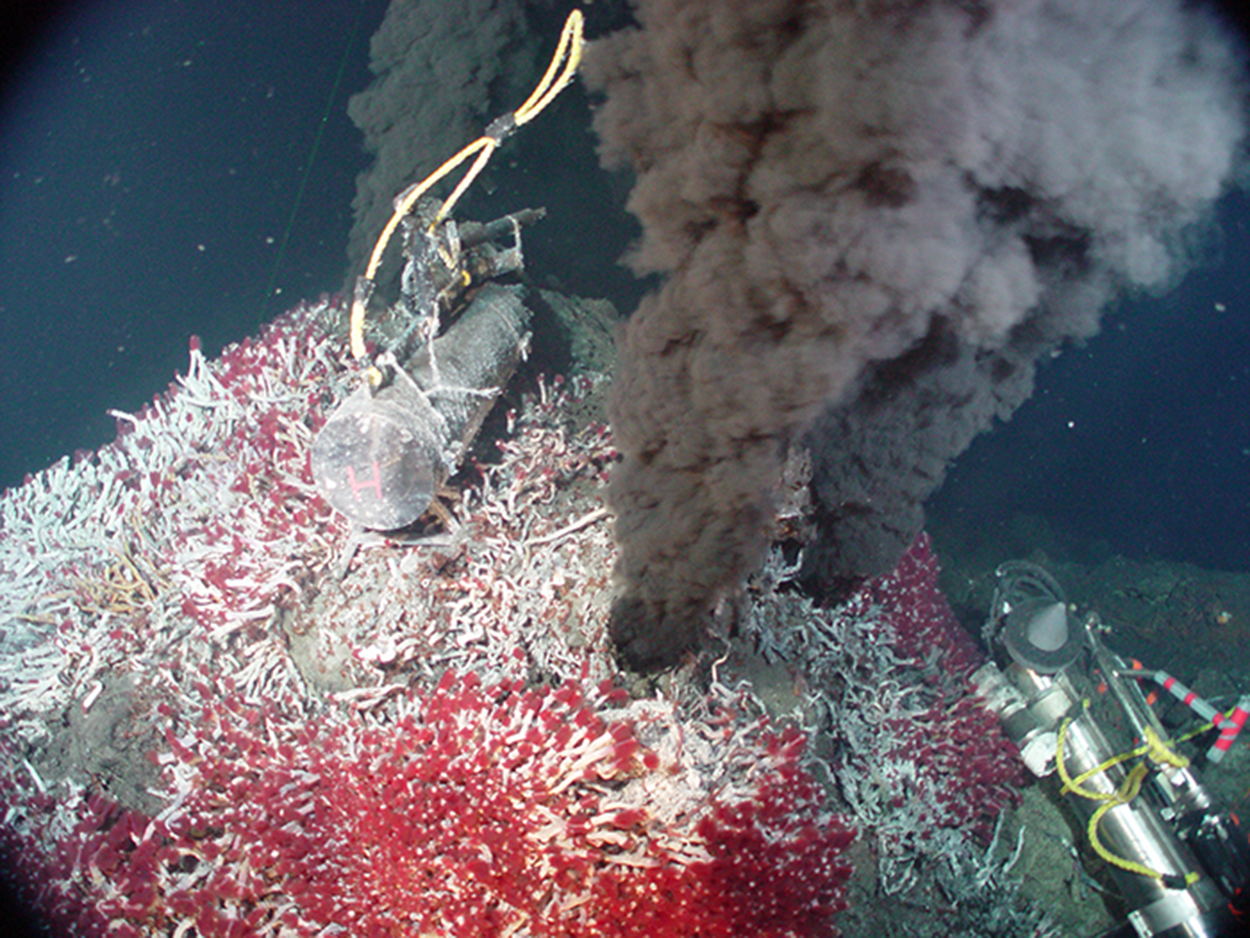
The image and table below summarize the major categories of organisms by temperature preferences.

| Name | Description | Optimum Growth Temperature | Notes |
|---|---|---|---|
| Psychrophiles | Cold-loving organisms; Can grow at 0 °C and below | Around 15 °C | Usually do not survive above 20 °C |
| Mesophiles | Prefer intermediate temperatures | Intermediate (including human body temperature) | Most human pathogens are in this group |
| Thermophiles | Heat-loving organisms | 50–80 °C | Do not multiply at room temperature |
| Hyperthermophiles | Growth ranges of 80–110 °C | Generally 80–100 °C | A few can even survive at about 121 °C |
Survival in extreme environments requires highly specialized adaptations. For example, the ratio of saturated lipids may increase to maintain membrane rigidity at higher temperatures and decrease to maintain membrane fluidity at lower temperatures. Some archaea have monolayer membranes that help maintain their structure at high temperatures. Organisms that thrive in extreme environments are called extremophiles and all types (not just those that thrive at high or low temperatures) have many unique adaptations that allow them to exploit resources and habitats unavailable to other organisms.
Many factors besides those already discussed can affect microbial growth and these factors can interact in complex ways. Factors of particular importance are solute concentration, barometric pressure, and light.
In general, microbes live in environments that have lower solute concentrations than their cytoplasm. Among other mechanisms, many organisms have cell walls that provide protection from bursting in these cases. When osmotic pressure is high (i.e., the solute concentration outside of the cell is higher than inside of the cell), then water tends to move out of the cell through osmosis and plasmolysis or crenation occurs.
Halophiles are microbes that thrive in environments with high salt concentrations. Extreme halophiles such as the archaeal genus Halobacterium thrive in even higher salt concentrations such as the conditions found in the Great Salt Lake of Utah. These organisms have several mechanisms of survival. Some pump out salt ions and maintain a high concentration of glycerol, Halobacterium species accumulate high concentrations of potassium ions in their cytoplasm and have proteins designed for high salt concentrations.
Halotolerant organisms do not require high salt concentrations in the way that halophiles do but are able to survive in relatively high salt concentrations. Some of these organisms are important pathogens because they can survive in food.
Other organisms can survive high barometric pressures, such as those found at the bottom of the ocean. These organisms are called barophiles and are difficult to study as it is so hard to replicate the conditions under which they thrive.
Finally, light is an important environmental factor that influences growth. As you have learned in other tutorials, some organisms are photosynthetic and require particular wavelengths of light to carry out photosynthesis. These organisms are found in a range of environments and require varying light intensities. They have varied combinations of photosynthetic pigments, and some require much higher concentrations of light than others.
Source: THIS TUTORIAL HAS BEEN ADAPTED FROM OPENSTAX “MICROBIOLOGY.” ACCESS FOR FREE AT openstax.org/details/books/microbiology. LICENSE: CC ATTRIBUTION 4.0 INTERNATIONAL.
REFERENCES
Liu, D., Wang, J., & Xie, Y. (2022). Refractory Helicobacter pylori infection and the gastric microbiota. Frontiers in cellular and infection microbiology, 12, 976710. doi.org/10.3389/fcimb.2022.976710